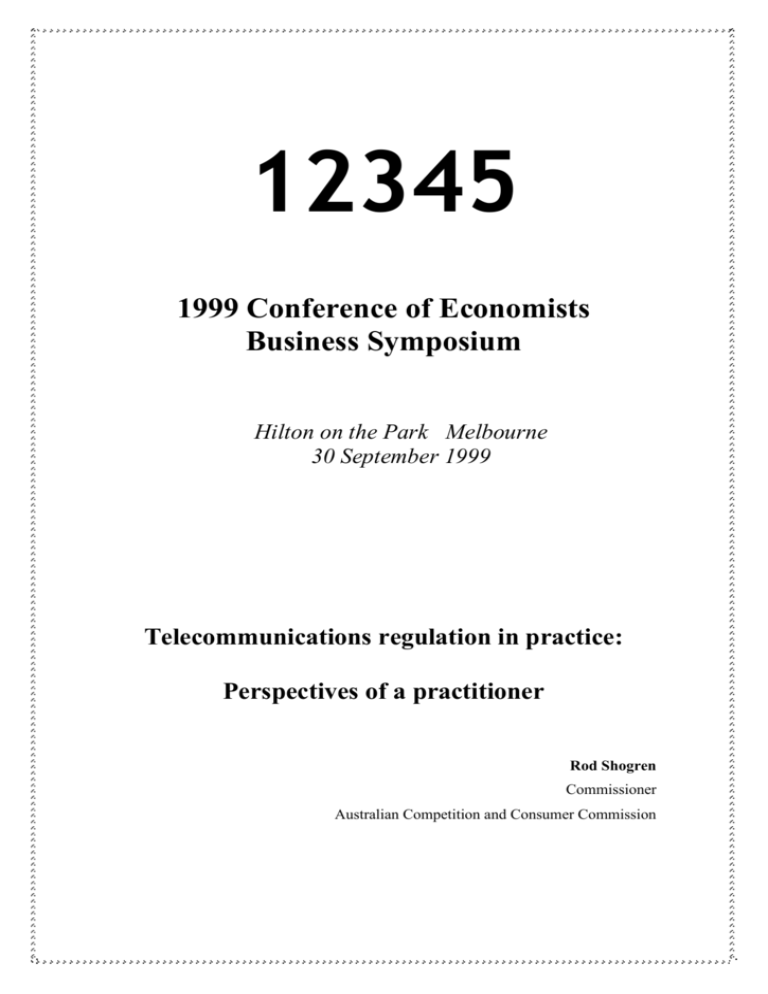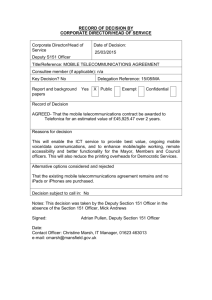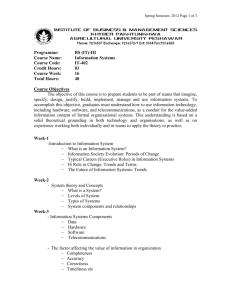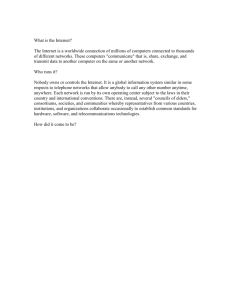Good morning, ladies and gentlemen
advertisement

12345 1999 Conference of Economists Business Symposium Hilton on the Park Melbourne 30 September 1999 Telecommunications regulation in practice: Perspectives of a practitioner Rod Shogren Commissioner Australian Competition and Consumer Commission Good morning, ladies and gentlemen You won’t learn as much from me about telecommunications regulation this morning as you have learnt from the two previous speakers about regulation of electricity and gas. Rather, I want to talk about some general principles of regulation; but, of course, I will do so as from my perspective as a telecommunications regulator. I take it that the topic today – regulation in practice – is deliberately intended to emphasise the practical aspects of regulation. Perhaps I detected some sense of impatience with academic theories, a desire to hear how it works in the real world. If that is the expectation, then what I say, at least at first, may disappoint you. That’s because one of my strongest guiding beliefs is that there is nothing more practical than theory. I have seen too much public policy put in place without the benefit of a strong analytical framework. Indeed, I believe that almost any analytical framework is better than none, although personally I haven’t found sociology all that useful. The generally used framework for competition regulation is applied economics tempered by considerations of social justice. That framework is consistent with the fact that most of the time our basic objective in competition and economic regulation is the achievement of economic efficiency in its three forms: technical efficiency, allocational efficiency and dynamic efficiency; together with a recognition that market outcomes may be at odds with society’s equity objectives. I stress that the framework applies to competition and economic regulation. There are other forms of regulation, eg regulation of content, that may need other frameworks. It may be noted that these other types of regulation are interacting more and more with competition regulation as convergence of telecommunications, broadcasting and IT continues apace. The applied economics framework thus goes to the objectives of regulation, ie efficiency, but it also gives us some guidance as to its tools. In addition, we need a framework for regulatory processes. That framework comes from ideas about natural justice and procedural fairness and from what I like to call “public administration values”: things like transparency, accountability, fairness and independence from party political interests. In addition, regulation - differently from, 2 say, public policy advising - needs to have independence not merely from party political interests but from government more fundamentally. Now, before I talk further about these frameworks, I would like to say something about what makes telecommunications special. We all have a sense of that – that we are dealing with networks, with communication that is generally two-way in nature, that interconnection is supremely important, and so on. But I believe it helps to step away for a moment from telecommunications and get a perspective on it by looking at another industry. What I suggest we do is consider air transport and do a simple thought experiment. What if one enterprise owned most of the airports in Australia and, in addition, owned one of the major domestic airlines? This airport corporation would allocate space for check-in counters: the check-in counters that were used by its subsidiary airline and by the competing airlines. The airport corporation would allocate timeslots for take-offs and landings: including timeslots for its airline and timeslots for the competing airlines. The airport corporation would set the charges for aircraft movements: its aircraft and aircraft of competing airlines. Now imagine the regulatory issues in all that. How light-handed would regulation of an airline industry that had that sort of structure be? The regulator of such an industry would have his or her work cut out. But that imaginary air transport industry is quite like the actual telecommunications industry. So, what are the key characteristics of telecommunications? Quite simply: on the one hand, the need by competitors for access to the incumbent’s network and, secondly, the vertical integration of the incumbent. In telecommunications, we are faced with massive opportunities for market power to be exercised, because the incumbent telecommunications company is vertically integrated across the whole market and has a legacy of a statutory monopoly from when it was fully publicly owned. Competitors need access to wholesale services supplied by the incumbent so that they can compete with the incumbent in providing services to endusers. 3 In those circumstances, a regulator can’t just muddle through or operate in an ad hoc manner. The regulator must have a strong framework, and the regulator must have appropriate powers. Now, I think it can be said that the stronger the powers, the less detailed the regulatory regime needs to be; or, more accurately, the more discretion that is given to the regulator, the less detailed the regulatory regime needs to be. But in Australia we very properly don’t use that approach. We tend not to like to give regulators broad discretions and we tend to like to set out the regulatory regime in considerable detail in legislation. We have a detailed regulatory regime and we allow the regulator to make heavily constrained decisions within it, and that’s fine by me. My life is regulated in many ways by different regulators and I feel much more comfortable knowing that those regulators work within detailed regulatory frameworks laid down by parliaments in legislation. This leads me to note that there have been observations lately about how privatisation has been associated, not with less regulation, but with more. To some extent, that’s true. When dealing with private sector industries with substantial market power that are vertically integrated and where competitors need access, inevitably there will be a fair bit of regulation. Following on from this, but even more to the point, in this new world of private utilities, the regulatory rules have to be spelled out in great detail, or the regulator has to be given huge discretions which, as I have said, is not our way in Australia. That spelling out is necessary because the regulation is now done by external regulators so that we can have the transparency, accountability, and procedural fairness that I talked about earlier. This is in contrast to the old way, where utilities regulated themselves and, to some considerable extent, also regulated whoever else had managed to find some space for themselves in the industry. Those who are now concerned about too much regulation need to remind themselves that the reason we are where we are is that we recognised that it was no longer good enough to let the telecommunications company regulate telecommunications, the electricity company regulate the electricity market and so on. I have spoken about the regulatory framework. I mentioned earlier the analytical framework, which gives us the objectives - in the case of telecommunications, the long 4 term interests of end-users - and the tools of regulation. In the case of telecommunications, that tool is declaration of a service, which is simply the creation of rights of access to telecommunications infrastructure in specified circumstances. That’s a very strong power. It is not common in our economy to give companies access to their competitor’s infrastructure, and it is something that needs to be done carefully. The justification in telecommunications lies in that story I told earlier about vertical integration, and competitors in retail markets using as inputs wholesale services provided by the incumbent. I also mentioned the procedural framework that derives from concepts of natural justice etc. I mentioned also that the regulatory framework tends to be detailed. How is this manifested? In legislation. Legislation that, frankly, is long and quite complicated. I am constantly surprised that marker players, who know what the regulatory framework consists of, nevertheless come to me and say: why don’t you just stop them doing this? Or: why don’t you make them do that? It needs to be remembered that the regulator exercises his or her powers in accordance with a detailed legislative framework. Let me speak now of the challenges of putting theory into practice. So far as the analytical framework is concerned, where our objectives can be generally characterised as seeking economically efficient outcomes, the major difficulty is uncertainty in a rapidly changing industry: uncertainty due to technological change, change in relationships, even change in people. So far as the procedural framework is concerned, it is important to have a stable regulatory regime. While fine tuning is sometimes necessary, including legislative amendment, major legislative change should be fairly rare. Finally, I would like to point out that there is a tension between some of the characteristics of good regulation. In particular, it is often said that regulators need to be flexible, especially in the light of rapidly changing markets and technologies. That is true. Regulators need to select from a range of regulatory tools as the situation demands. They need to stay up to date with new thinking. They need to recognise when old ways no longer work. This is nowhere more the case than in 5 telecommunications, which I think most people acknowledge is one of the most rapidly changing industries. But regulators also need to be consistent and predictable. There are lots of temptations for regulatory opportunism. Players in the market need to know where they stand. Regulators need to take the long term view and, believe me, they come under massive short term pressures. Especially, I would say, in rapidly changing markets, where flexibility is needed, regulators should be cautious, nevertheless, about changing their approach too rapidly. In my view, the flexibility part is relatively easy. It is the consistency that is harder to maintain and that’s where many of the regulatory dangers lie. Thank you. 6





